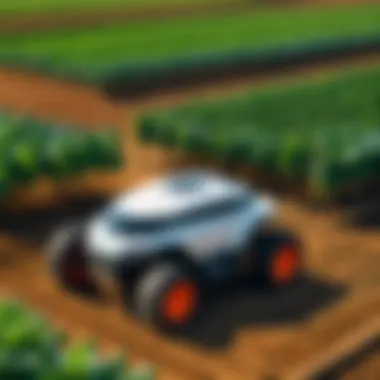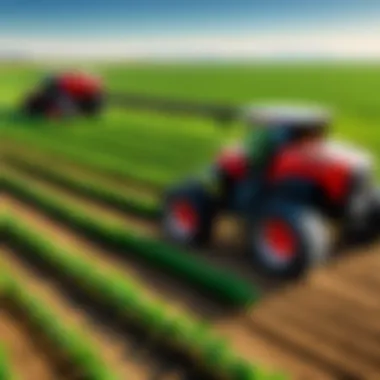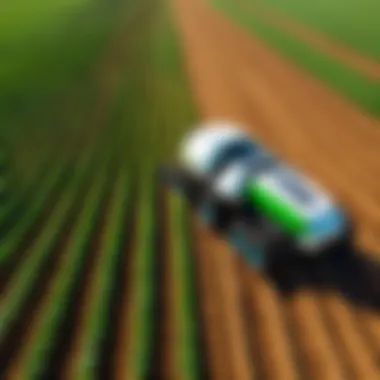The Rise of Farm Bots: Transforming Agriculture Through Automation


Overview of Farm Bots Revolution
In the realm of modern agriculture, a groundbreaking revolution is unfolding with the emergence of farm bots. These automated marvels are not just technological novelties but are reshaping the very essence of farming practices worldwide. By harnessing the power of automation, farm bots are ushering in a new era of efficiency and cost-effectiveness in agriculture. Let's delve deeper into the transformative potential of these mechanical allies and their far-reaching impact on the agricultural landscape.
Types and Functionalities of Farm Bots
Farm bots come in various shapes and sizes, each catering to specific tasks within the agricultural domain. From autonomous tractors that can plow fields with precision to drones equipped with sensors for crop monitoring, the functionalities of these bots are as diverse as the crops they nurture. With advancements in AI and robotics, farm bots are not just automated machines but intelligent assistants capable of intricate decision-making processes. Understanding the different types and functionalities of farm bots will offer a glimpse into the future of agriculture, where technology and nature harmoniously converge.
Benefits of Farm Bots in Agriculture
The integration of farm bots into traditional farming practices brings forth a multitude of benefits that extend beyond mere productivity gains. By streamlining manual labor, farm bots reduce the physical strain on farmers while significantly cutting down operational costs. Furthermore, their ability to work around the clock ensures timely intervention in crop management and pest control, leading to enhanced yields and agricultural sustainability. Exploring the myriad benefits of farm bots unveils a promising horizon for agriculture, where innovation paves the way for a more efficient and eco-conscious farming ecosystem.
Synthesis of Farm Bots' Impact on Agriculture
As we navigate through the realm of farm bots revolutionizing agriculture through automation, it becomes evident that the marriage of technology and farming practices is not just a fleeting trend but a transformative shift. From optimizing resource utilization to promoting sustainable farming methods, farm bots are catalysts for change in an industry grappling with evolving challenges. By synthesizing the myriad ways in which farm bots impact agriculture, we gain a holistic perspective on how automation is reshaping the agricultural landscape for the better.
Intro to Farm Bots
The realm of agriculture undergoes a profound transformation as farm bots emerge into the spotlight, revolutionizing traditional farming practices through automation. This pivotal shift towards technology-driven agriculture signifies a significant leap in efficiency, productivity, and sustainability within the industry. Introducing farm bots sets the stage for a discourse on the evolution and impact of automated farming technologies, unveiling a new era in agricultural practices empowered by innovation and precision.
Defining Farm Bots
Overview of automated farming technologies
At the core of modern agriculture lies the essence of automated farming technologies, redefining how farmers cultivate the land and harvest crops. The essence of automated farming technologies lies in their ability to streamline tasks, enhance precision, and optimize resource allocation. These technologies represent a paradigm shift from manual labor to intelligent systems, offering unprecedented efficiency and scalability in agricultural operations. The fusion of robotics, AI, and sensory technologies encapsulates the essence of automated farming, marking a pivotal moment in the agrarian landscape.
Evolution of Farm Bots
Historical development of agricultural automation
Tracing the historical trajectory of agricultural automation unveils a narrative of innovation and perseverance in addressing the challenges of traditional farming methods. The historical development of agricultural automation symbolizes humanity's quest for efficiency, sustainability, and resilience in food production. From the rudimentary tools of the past to the sophisticated farm bots of today, this evolution reflects our continuous effort to harness technology for the betterment of agricultural practices. Embracing automation in agriculture signifies not just progress but a commitment to a more sustainable and productive future for farming communities worldwide.
Significance of Farm Bots


Impact on productivity and sustainability
The impact of farm bots on productivity and sustainability reverberates across the agricultural landscape, fundamentally altering how farmers approach cultivation and land management. The integration of farm bots results in a significant uptick in operational efficiency, leading to higher yields, reduced waste, and improved profitability. Furthermore, the adoption of automation fosters sustainable farming practices by minimizing resource use, optimizing inputs, and mitigating environmental degradation. The significance of farm bots transcends mere technological innovation, embodying a paradigm shift towards a more prosperous, ecologically conscious agricultural sector.
Types of Farm Bots
In the realm of modern agriculture, the significance of Types of Farm Bots cannot be overstated. These automated marvels have revolutionized farming practices, leading to increased efficiency, reduced labor costs, and optimized resource utilization. As we delve into the realm of farm bots, we uncover a world where harvesting robots, weeding robots, and planting robots play a pivotal role in reshaping the agricultural landscape. Understanding the nuances and benefits of each type is essential to grasp the transformative power they hold over traditional farming methods.
Harvesting Robots
When it comes to automated fruit and vegetable picking machines, efficiency and precision are at the forefront of their contribution. These robots are designed to streamline the harvesting process, ensuring that crops are gathered with the utmost care and speed. The key characteristic of automated fruit and vegetable picking machines lies in their ability to differentiate between ripe and unripe produce, thereby minimizing wastage and maximizing productivity. Their unique feature of gentle handling preserves the quality of the harvest, making them a popular choice for modern farms looking to enhance their efficiency.
Weeding Robots
Mechanized weed control systems have become indispensable in modern agriculture, offering a targeted approach to combating unwanted plant growth. The key characteristic of these robots is their ability to distinguish between crops and weeds, ensuring that the latter are targeted with precision. By minimizing the need for herbicides and manual labor, weeding robots contribute significantly to sustainable farming practices. Their unique feature of autonomous operation reduces the dependency on human intervention, making them a beneficial choice for farms looking to minimize environmental impact.
Planting Robots
Seed sowing and transplanting mechanisms play a crucial role in the farming ecosystem, enabling efficient cultivation and management of crops. The key characteristic of these robots is their precision in seeding and transplanting, ensuring optimal spacing and depth for each plant. This level of accuracy results in improved germination rates and overall crop health. Their unique feature of customizable settings allows for adaptability to different crop varieties and field conditions, making them a popular choice for farmers seeking consistency and reliability in their planting practices.
Functionalities of Farm Bots
In this crucial section of the article, we delve into the core functionalities that underpin the revolutionary impact of farm bots on modern agriculture. The efficiency and cost-effectiveness that automation brings to farming practices are paramount in today's rapidly evolving agricultural landscape. Understanding the nuances of the functionalities of farm bots is essential to grasp their transformative power in reshaping traditional farming methods.
Automation of Farming Tasks
Efficient crop maintenance and management
Efficient crop maintenance and management stand at the forefront of streamlined agricultural operations. By automating key tasks such as watering, fertilizing, and monitoring plant health, farm bots enable farmers to optimize their crop yields efficiently. The ability to precisely regulate crop maintenance activities not only saves time but also enhances the overall health and productivity of the plants. The allure of efficient crop maintenance lies in its capacity to deliver consistent care to crops without human error, ensuring a high level of accuracy and precision throughout the cultivation process. This strategic approach to crop management proves to be a game-changer, particularly in large-scale farming scenarios, where time and resource optimization are critical for sustainable agricultural practices.
Precision Agriculture
Targeted application of resources for optimized yields


Precision agriculture redefines the traditional farming model by emphasizing the strategic utilization of resources to maximize crop yields. Through the pinpoint accuracy of farm bots, farmers can tailor the distribution of resources such as water, pesticides, and fertilizers to specific areas of their fields, ensuring optimal plant growth and minimal waste. The key characteristic of targeted resource application lies in its ability to enhance productivity while minimizing environmental impact. This approach not only promotes sustainable farming practices but also contributes to the economic viability of agricultural operations. However, challenges may arise in terms of initial setup costs and technological integration, requiring farmers to weigh the benefits against the investment involved.
Data-driven Decision Making
Utilizing sensor data for informed farming practices
Data-driven decision-making represents the cornerstone of modern agricultural management, where the utilization of sensor data plays a pivotal role in steering farming practices towards greater efficiency and output. By harnessing real-time data on soil quality, weather patterns, crop growth, and pest infestations, farm bots empower farmers to make informed decisions that optimize crop health and productivity. The unparalleled advantage of utilizing sensor data lies in its ability to provide actionable insights that drive proactive intervention and preventive measures in crop management. However, reliance on technology for decision-making raises concerns about data accuracy and cybersecurity vulnerabilities, highlighting the importance of robust data protection protocols in agricultural automation.
Benefits of Farm Bots
In the realm of modern agriculture, the advent of farm bots heralds a new era of efficiency and sustainability. The significance of integrating farm bots lies in their ability to revolutionize traditional farming practices. From streamlined operations to cost-effective solutions, these automated systems offer a myriad of benefits to the agricultural industry. Embracing farm bots translates into heightened productivity, reduced labor costs, and improved resource management. By delving deep into the realm of farm bots, one can unravel the transformative impact these technological marvels possess.
Increased Efficiency
Reduced operational time and enhanced productivity
Delving into the specifics of reduced operational time and enhanced productivity reveals a cornerstone of the farm bot revolution. This aspect underscores the ability of automated systems to expedite farming tasks, thereby maximizing output. The key characteristic of reduced operational time and enhanced productivity lies in its time-saving attributes. By streamlining operations and minimizing manual intervention, farm bots elevate efficiency levels to unprecedented heights. The unique feature of this facet is its seamless integration into existing agricultural processes, optimizing workflows and boosting overall productivity. While there are notable advantages to this streamlined approach, challenges such as technical complexities and system maintenance must also be considered within the context of operational efficiency.
Cost Savings
Minimized labor expenses and optimized resource utilization
Exploring the realm of cost savings through minimized labor expenses and optimized resource utilization sheds light on the financial benefits of farm bot adoption. This aspect plays a pivotal role in curbing operational costs and maximizing resource efficiency. The key characteristic of minimized labor expenses and resource optimization lies in its ability to reduce overheads associated with manual labor. By leveraging cutting-edge technologies, farmers can achieve significant cost reductions while enhancing output quality. The unique feature of this facet is its strategic allocation of resources, ensuring optimal utilization and minimal wastage. While the advantages of cost savings are pronounced, challenges such as initial investment costs and technological reliance pose considerations in the realm of financial sustainability.
Environmental Sustainability
Lowered carbon footprint and reduced chemical usage
The narrative on environmental sustainability is underscored by the contributions of farm bots towards lowering carbon footprints and minimizing chemical usage. This particular aspect emphasizes the role automated systems play in promoting eco-friendly farming practices. The key characteristic of lowered carbon footprint and reduced chemical usage lies in its eco-conscious approach to agriculture. By reducing reliance on fossil fuels and harmful chemicals, farm bots pave the way for a greener future in farming. The unique feature of this facet is its impact on biodiversity conservation and long-term ecological balance. While the advantages of environmental sustainability are significant, challenges such as regulatory compliance and technological limitations warrant careful consideration in the pursuit of sustainable agricultural practices.
Challenges and Limitations
In the realm of revolutionizing agriculture through automation, it is imperative to dissect the Challenges and Limitations that accompany this transition. These facets serve as crucial pillars shaping the landscape of modern farming practices. Understanding the obstacles and drawbacks faced in integrating farm bots into existing agricultural systems is paramount to realizing the full potential of this technological advancement. By addressing Challenges and Limitations head-on, stakeholders can strategize and innovate to overcome these hurdles, propelling the agricultural sector towards unprecedented growth and sustainability.


Technological Constraints
Reliability issues and system maintenance challenges
Delving into the core of Technological Constraints, the intricate web of Reliability issues and system maintenance challenges emerges as a pivotal focal point. These challenges encompass the reliability concerns surrounding farm bot technologies and the maintenance intricacies essential for their seamless operation. The reliability aspect delves into the consistent performance expectations that farm bots must meet to ensure uninterrupted farming processes. Concurrently, system maintenance challenges highlight the technological upkeep required to sustain optimal functionality and prevent downtimes. The interconnected nature of reliability and maintenance underscores their critical role in maximizing the efficiency and efficacy of automated farming systems. Recognizing the quintessence of addressing these challenges is vital in fostering a robust foundation for the integration of farm bots, driving agricultural innovation further.
Adaptation Hurdles
Resistance to change and skills gap in workforce
Within the realm of Adaptation Hurdles, the formidable barriers of Resistance to change and the skills gap in the workforce take center stage. Resistance to change encapsulates the hesitance or reluctance observed in transitioning from traditional farming methods to automated systems. This resistance emanates from various factors such as familiarity with conventional practices, fear of technology, or even cultural norms deeply rooted in agricultural communities. Conversely, the skills gap in the workforce highlights the disparity between the technical competencies required to operate farm bots efficiently and the current skill sets prevalent among agricultural workers. Bridging this gap through training, education, and awareness is essential to optimize the benefits brought forth by automated farming technologies. Unveiling the nuances of resistance and skills misalignment sheds light on the multifaceted challenges impeding the seamless adoption of farm bots within agricultural settings.
Ethical Considerations
Impact on employment and rural communities
Ethical Considerations propel the discourse towards the ethical ramifications associated with the integration of farm bots, particularly in terms of Impact on employment and rural communities. This facet delves into the socio-economic implications of automated farming, unraveling the effects on employment opportunities within the agricultural sector and the fabric of rural communities. The advent of advanced technologies poses a dual challenge of potentially displacing human labor while simultaneously streamlining agricultural operations. Assessing the nuanced effects of this transformation on livelihoods, socio-cultural dynamics, and community cohesion is imperative in navigating the ethical quandaries entwined with agricultural automation. By dissecting the intricate tapestry of impacts on employment and rural communities, stakeholders can forge holistic strategies that prioritize ethical considerations alongside technological advancements, ensuring a harmonious transition towards automated farming practices.
Future Prospects
Automation in agriculture is on a relentless trajectory towards the integration of cutting-edge technologies like artificial intelligence (AI) and robotics. This pivotal shift signifies a leap into a future where farming practices are driven by data-driven decision-making and precision techniques. One of the primary focal points in this article is exploring the potential avenues that Future Prospects offer for revolutionizing agricultural landscapes worldwide.
Advancements in AI and Robotics
Integration of artificial intelligence for enhanced farm bot capabilities
The seamless synergy of artificial intelligence with robotics presents a transformative phase in automated farming. Integration of AI empowers farm bots to adapt dynamically to changing environmental factors, enhancing operational efficiency and precision in agricultural tasks. The quintessence of this advancement lies in the ability of farm bots to make autonomous decisions based on real-time data analysis, leading to optimized crop management practices. A noteworthy characteristic of integrating AI into farm bots is the scalability it offers, allowing for customization based on varying farm sizes and produce requirements. Despite challenges such as data security and algorithm biases, the incorporation of AI in farming technology remains a salient choice, catering to the demand for sustainable and efficient agricultural practices.
Global Adoption Trends
Expansion of automated farming practices worldwide
The phenomenon of automation in agriculture is not constrained by geographical boundaries but is a global trend reshaping the industry. The key characteristic of the global adoption trend is the universal recognition of the benefits it brings, such as increased productivity, reduced labor dependency, and enhanced sustainability. By automating farming practices worldwide, countries are gearing towards food security, economic competitiveness, and environmental conservation. A unique feature of this trend is the cross-pollination of farming technologies and best practices across different regions, fostering a collaborative ecosystem for agricultural innovation and growth. While challenges like infrastructural limitations and regulatory disparities exist, the advantages of global adoption trends in automated farming outweigh the drawbacks, leading to a unified and progressive landscape in agricultural automation.
Regulatory Frameworks
Policy implications for the governance of agricultural automation
Developing comprehensive regulatory frameworks is paramount for the ethical and effective implementation of automated farming technologies. The key characteristic of policy implications lies in striking a balance between promoting innovation and safeguarding farmers' interests, consumer health, and environmental sustainability. By establishing clear guidelines and standards, regulatory bodies can ensure safe integration of automation in agriculture while addressing concerns related to data privacy, food safety, and ethical use of technology. A unique feature of these frameworks is their adaptability to evolving technological landscapes, allowing for continuous improvement and alignment with international standards. While navigating issues like compliance complexities and enforcement challenges, policy implications for agricultural automation play a crucial role in shaping a sustainable and responsible future for automated farming practices.







